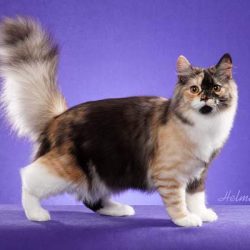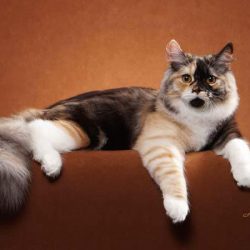Helmi says:
“Tammy Ardolf brought us “Mila” a stunning Siberian from Sue Case’s Cattery to photograph at our studio here at home. What an excellent poser!”
These are thumbnail images. If you click on them you are taken to larger versions.
The celebrated cat photographer has a studio at her home in Bedford, Texas. Sometimes cat breeders and owners bring their cats to her to be photographed or they are photographed at a cat show. At cat shows the organisers provide a space annexed to the show hall where Helmi and her husband can set up their mobile studio. During the show the breeders come to the studio for a photo session. They are quite quick for the simple reason that the precious subject – a superb looking glamour show cat – has a limited attention span.
As a cat photographer you don’t want to test your subject’s patience. I’d say that the actual photography takes around ten minutes. The studio set up and getting the cats into position are carried out by Helmi’s husband, Ken, while Helmi takes the photo on a high-end full-frame digital camera. Flash light is used which freezes the movement of the cat. The cats don’t mind flashlight.
Some cats are better subjects than others. The better ones naturally provide a good composition through their movements. Helmi wants something better than a cat sitting down looking uninterested. It can be tricky to get a cat to provide nice shapes.
I regard the Siberian as part of a trio of similar cat breeds: Norwegian Forest cat, Siberian cat and the Maine Coon. They are similar in appearance. Of the three, the Maine Coon is the most popular and therefore there are more of them. Maine Coon breeders create these extraordinary square muzzles and large, triangular lynx-tipped ears, which distinguish the Maine Coon from the other two breeds. The Siberian is a larger than average cat breed while the Maine Coon is the largest domestic cat breed (excluding F1 wild cat hybrids).
Some say the Siberian has that magical quality of being hypoallergenic. It is a good selling point and good marketing. It has not been proved scientifically.
Dr Desmond Morris, a cat expert, calls the cat the ‘Siberian Forest Cat’. He says that it is an ‘ancient long-haired breed now believed to have been ancestral to all modern long-haired cats including the Angora and the Persian….Most commonly found in Northern Russia especially around St. Petersburg…The breed has been present in Russia for centuries’. The heavy coat protects against the bitter winter chill.
In Russian today you’ll see Siberian cats on farms. They are not purebred in the sense that show cats are purebred in the US but they are as pure or purer genetically than the US variants.
Siberians were first imported into America in 1990. The first litter was born in the US in October of that year. It was exhibited in the International Cat Show in New York in 1991.
[weaver_breadcrumbs class=’alt-class’ style=’inline-style’]
[weaver_show_posts cats=”” tags=”Helmi-Flick” author=”” author_id=”” single_post=”” post_type=” orderby=”date” sort=”ASC” number=”2″ show=”full” hide_title=”” hide_top_info=”” hide_bottom_info=”” show_featured_image=”” hide_featured_image=”” show_avatar=”” show_bio=”” excerpt_length=”” style=”” class=”” header=”” header_style=”” header_class=”” more_msg=”” left=0 right=0 clear=0]




